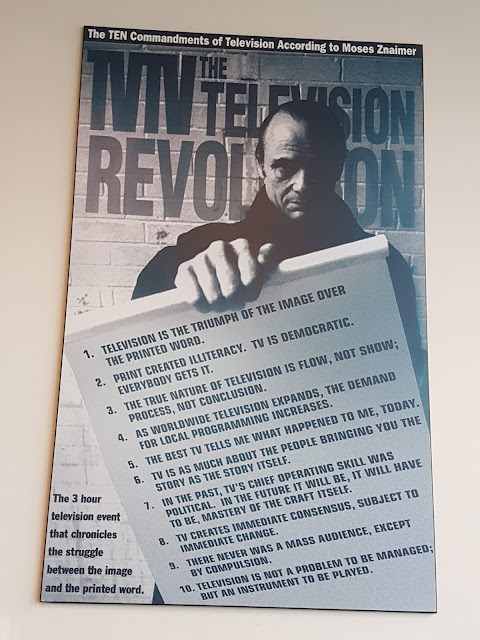We had walked by this (unknown to us) museum during the summer as we explored Liberty Village. At that time we didn't stop in.
Since we were back for another lunch we decided to step inside the museum.
We were greeted by a receptionist who said it only opened at 2 PM and she would get a guide for us.
What/who is MZ? Moses Znaimer is Toronto's own visionary prophet of the airwaves. He is also a co-founder and former head of Citytv, the first independent television station in Toronto, and the current head of ZoomerMedia.
When we moved to Toronto in the early 90s, Citytv was a breath of fresh air after watching Canadian and American networks. This was local and edgy.
The ultimate "zoomer"!
Back to the museum:
Dedicated to preserving the technological history of the television receiver, this museum has a specialized collection of British and North American TV receivers and related items. Housed in the heart of Liberty Village, the museum's collection spans the evolution of television from 1920s mechanical scanning discs to 1970s solid-state electronics.
We are led down a hallway lined with vintage radios and TVs.
Also lining the hall were these fabulous works of art, I am tracking down the artist's name.
An altar to the 50s. Did you know that there is a patron saint of television????
Check out the middle of the TV screen.
Later we saw this FACT in the museum.
Pope Pius XII designated Clare as the patron saint of television in 1958 on the basis that when she was too ill to attend Mass, she had reportedly been able to see and hear it on the wall of her room.
If the staff lounge The Writing on the Wall Television in Quotes.
Moses with the Ten Commandments of Television.
We were given an overview to the museum and its excellent app by Darryl Komaromi, Director Social Media Community Relations and then left on our own to wander. Darryl came back at the end of the tour to get our positive feedback.
I will admit I had no idea who invented television!
Philo Taylor Farnsworth (August 19, 1906 – March 11, 1971) was an American inventor and television pioneer.He made many contributions that were crucial to the early development of all-electronic television. He is best known for his 1927 invention of the first fully functional all-electronic image pickup device (video camera tube), the "image dissector", as well as the first fully functional and complete all-electronic television system. Farnsworth developed a television system complete with receiver and camera which he produced commercially in the form of the Farnsworth Television and Radio Corporation from 1938 to 1951 in Fort Wayne, Indiana.
This article contains information on the other pioneers.
I was totally intrigued by his first name Philco but couldn't find how he came by it.
Who was Television’s First Star?
I was totally intrigued by his first name Philco but couldn't find how he came by it.
Who was Television’s First Star?
Felix The Cat – This Very Figure of Him
Felix rose to TV stardom in the late 1920s, when the American communications giant, RCA, chose him as a test subject for its television research. The lighting required to reflect images into the primitive television camera of the day proved far too hot for humans to stand, so using an inanimate object was the only option.
The engineers purchased this papier maché figurine of FELIX from the famed toy store, F.A.O. Shwartz in New York City, just up 5th Avenue at 57th Street from their own offices at Rockefeller Centre. Felix fell off his turntable often, which explains his “imperfect” condition. First his tail fell off, then his head, which was reattached with a drumstick.
It was in 1928 that RCA first broadcast Felix from the Empire State Building. Later, Felix was honoured when RCA transmitted his image on the first commercial television broadcast in 1939, as a lead up to the formal unveiling of television at the New York World’s Fair. Thus, Felix the Cat became Television’s First Star!
Before his television debut, this cat enjoyed many lives in animated film. Created by Otto Messmer, the initial series played from 1920 to 1928. The fun-loving cat made a comeback in 1936, starring in three short films. Then, in 1960, a new series was produced for television that featured the debut of Felix’s magic bag of tricks.
Felix’s most recent performance occurred in 1991, at the Ed Sullivan Theatre in New York City, as part of the first demonstration of High Definition Television in the USA.
I'm going to let the photos and descriptions speak for themselves.
I love this beauty!
From Marilyn to Elvis
Yet more televisions.
The MZTV Museum posted a link to this post on their Facebook page!








































































Beautiful old models. That's the first time I've heard of the place.
ReplyDeleteWhat a great museum. I love the '57 German entertainment centre.
ReplyDelete